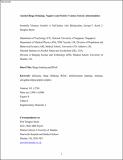Files in this item
Alcohol binge drinking : negative and positive valence system abnormalities
Item metadata
| dc.contributor.author | Tolomeo, Serenella | |
| dc.contributor.author | McFarlane, Jennifer A. | |
| dc.contributor.author | Baldacchino, Alex | |
| dc.contributor.author | Koob, George F. | |
| dc.contributor.author | Steele, J. Douglas | |
| dc.date.accessioned | 2021-09-15T23:42:23Z | |
| dc.date.available | 2021-09-15T23:42:23Z | |
| dc.date.issued | 2020-09-16 | |
| dc.identifier | 270229541 | |
| dc.identifier | 352af1f7-71bf-45e3-ad40-06c2dad5ff5f | |
| dc.identifier | 85096652347 | |
| dc.identifier | 000607876300016 | |
| dc.identifier.citation | Tolomeo , S , McFarlane , J A , Baldacchino , A , Koob , G F & Steele , J D 2020 , ' Alcohol binge drinking : negative and positive valence system abnormalities ' , Biological Psychiatry: Cognitive Neuroscience and Neuroimaging , vol. In press . https://doi.org/10.1016/j.bpsc.2020.09.010 | en |
| dc.identifier.issn | 2451-9022 | |
| dc.identifier.other | RIS: urn:860A93DE1D28A620F8C4C4A2380173C9 | |
| dc.identifier.other | ORCID: /0000-0002-5388-7376/work/80620762 | |
| dc.identifier.uri | https://hdl.handle.net/10023/23968 | |
| dc.description | This work was supported by an award from Dundee University Medical School (ref. AT27) to ST and JDS. Spectroscopy was supported by an unrestricted ‘Work in Progress’ agreement with Siemens. | en |
| dc.description.abstract | Background: Three million deaths occur each year due to alcohol misuse. Translational studies are crucial to translate preclinical findings to patients. Preclinical studies have highlighted abnormalities in specific brain systems with these forming the basis of allostasis theory. However, few studies have tested predictions in humans using neuroimaging. Methods: Here we used a Research Domain Criteria (RDoC) approach to testallostasis theory predictions of blunted positive valence system (PVS) and abnormally increased negative valence system (NVS) responses in fifty-seven binge alcohol drinking subjects and healthy controls who completed an instrumental task during fMRI. Results: As hypothesised, binge alcohol drinkers showed abnormally increased activity in NVS-linked regions such as the hippocampus and dorsal cingulate, and abnormally blunted activity in PVS-linked regions such as the striatum, compared to controls. Higher measures of problematic alcohol use were associated with more abnormal brain activity, only for binge drinkers who had been most recently drinking. Conclusions: These results support allostasis theory predictions of abnormally increased NVS and blunted PVS responses in binge alcohol drinkers. Further similar translational neuroimaging studies are indicated, particularly focusing on the NVS | |
| dc.format.extent | 1076851 | |
| dc.language.iso | eng | |
| dc.relation.ispartof | Biological Psychiatry: Cognitive Neuroscience and Neuroimaging | en |
| dc.subject | Allostasis | en |
| dc.subject | Binge drinking | en |
| dc.subject | RDoC | en |
| dc.subject | Reinforcement learning | en |
| dc.subject | Striatum | en |
| dc.subject | Amygdala-hippocampal complex | en |
| dc.subject | RA0421 Public health. Hygiene. Preventive Medicine | en |
| dc.subject | RC0321 Neuroscience. Biological psychiatry. Neuropsychiatry | en |
| dc.subject | DAS | en |
| dc.subject | SDG 3 - Good Health and Well-being | en |
| dc.subject.lcc | RA0421 | en |
| dc.subject.lcc | RC0321 | en |
| dc.title | Alcohol binge drinking : negative and positive valence system abnormalities | en |
| dc.type | Journal article | en |
| dc.contributor.institution | University of St Andrews. Population and Behavioural Science Division | en |
| dc.contributor.institution | University of St Andrews. Centre for Minorities Research (CMR) | en |
| dc.contributor.institution | University of St Andrews. School of Medicine | en |
| dc.identifier.doi | 10.1016/j.bpsc.2020.09.010 | |
| dc.description.status | Peer reviewed | en |
| dc.date.embargoedUntil | 2021-09-16 | |
| dc.identifier.url | https://www.sciencedirect.com/science/article/pii/S2451902220302792#appsec1 | en |
This item appears in the following Collection(s)
Items in the St Andrews Research Repository are protected by copyright, with all rights reserved, unless otherwise indicated.

